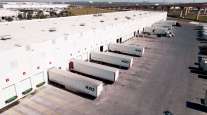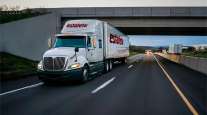Managing Editor, Features and Multimedia
UPS Routing Program ORION Helps Drivers Trim Miles, Reduce Costs

This story will appear in the Sept. 12 issue of iTECH, a supplement to Transport Topics.
TIMONIUM, Md. — A UPS driver delivers packages to about 120 stops on a typical route, but the number of potential ways to go about that task is virtually infinite.
Mathematically, the set of possible delivery sequences for that many stops far surpasses the number of nanoseconds the Earth has existed.
How, then, can a driver ever hope to find the most efficient route to make those deliveries, while also ensuring that all packages arrive by their promised delivery times?
To help address that challenge, UPS has developed ORION, a program that calculates an optimized delivery order aimed at reducing miles traveled, transit time and fuel consumption.
The software uses fleet telematics data, customized maps and a proprietary algorithm to generate routes that a human likely never would have considered.
ORION’s way of “thinking” was on display July 19 during a hands-on demonstration arranged by UPS for Transport Topics.
The demo included a ride-along on a delivery route near the UPS information services facility here, where the company developed and refined ORION.
At times, ORION’s pre-calculated delivery sequence directed the driver to continue right past several residential stops on the way to another delivery — a move that might seem counterintuitive to a human. The algorithm, however, determined that it actually would be less expensive to come back later in the day.
The time needed to make those extra stops might have prevented the driver from making a more efficient choice, or could have put other service commitments in jeopardy, said Jack Levis, UPS’ senior director of process management for corporate engineering.
Levis explained that ORION, which stands for On-Road Integrated Optimization and Navigation, improves efficiencies by finding small ways to save a minute or a fraction of a mile here and there.
 Seth Clevenger/Transport Topics
Seth Clevenger/Transport Topics Eliminating one mile per driver per day is worth $50 million annually at UPS, while trimming one minute is worth $14.6 million, Levis said.
“Because of this, we pay attention to little details,” he said. “We don’t have to go look for 20 miles. Just find one.”
Automating the delivery route also helps reduce driver stress, Levis added. “Let them focus on safety and customer service, and let ORION make the little decisions for them.”
That’s not to say that ORION’s delivery sequences are perfect. The program uses the same algorithm for all of its routes, covering many different geographies, so UPS still encourages drivers to use their own judgment if they see an opportunity to improve upon the pre-calculated order. If running ahead of schedule, for example, a driver may choose to make an extra stop in a given area.
“Technology by itself and humans by themselves are not as good as technology and a human together,” Levis said. “The drivers can do some things that ORION can’t do.”
UPS developed and tested the algorithm behind ORION over the course of a decade before beginning its initial rollout in 2013. By mid-July, UPS was only weeks away from completing its planned deployment of the program across the vast majority of its U.S. package delivery operations.
UPS expects ORION to reduce miles driven by 100 million and fuel consumed by 10 million gallons each year, resulting in cost savings of $300-400 million in the United States.
The ORION demo featured specialized tablets that provided package information, an estimated time of arrival for each stop and a map showing the location of upcoming deliveries to aid navigation.
The functionality shown on those tablets is available to UPS route planners, but the drivers currently see only ORION’s delivery sequence.
However, drivers can use kiosks at UPS facilities to preview their routes and learn more about how the algorithm makes its decisions.
Today, the route created by ORION is static once the driver embarks in the morning, but in the future, UPS intends to enable dynamic routing. That would allow ORION to automatically update the route throughout the day to account for new pickups or make adjustments if the driver deviates from the predetermined order. Other future updates could add live traffic and weather information.
UPS also is planning to add a navigation feature for drivers, Levis said.
Moving forward, UPS said the deployment of ORION will help the company support a trend toward more personalized service options.
UPS My Choice, for example, enables customers to receive delivery alerts and reroute packages if they won’t be home, or provide instructions for the driver about where to leave them. For a fee, customers can also confirm a specific time window for delivery.
Now that UPS has redesigned is final-mile delivery process, Levis said the company has turned its attention to applying the same methodology to other areas of its business, including over-the-road transportation and operations inside its facilities, such as package sortation and washing vehicles.
Levis said UPS frequently fields calls from businesses interested in ORION, but the core algorithm is highly tailored to UPS operations and does far more than most companies would ever need. However, the knowledge of operations research UPS gained from building ORION has much broader value, he added.
“If you’re doing anything in transportation, operations research is a discipline that should be integral to everything you do,” Levis said.
UPS Inc., based in Atlanta, ranks No. 1 on the Transport Topics Top100 list of the largest for-hire carriers in the United States and Canada.
ORION is emblematic of a broader technology trend — the movement toward actively harnessing data to guide operations rather than merely collecting data and analyzing it after the fact.
Levis described the evolution of data analytics as a continuum, starting with descriptive analytics, which provides basic insight into what happened, and then diagnostic analytics, which seeks to explain why something happened. The next steps are forecasting what will happen through predictive analytics, and, finally, planning what to do through prescriptive analytics.
“As you move through this continuum, your business benefits grow,” Levis said. “If your vision stops at descriptive analytics, or if your vision stops at predicting, you’re leaving a lot on the table.”
ORION is a form of prescriptive analytics, the final stage of that evolution, but UPS could only implement that program after building a foundation from other technologies and process improvements.
More than a decade ago, UPS introduced package flow technologies to streamline sortation and delivery. That rollout incorporated data modeling and smart labels to improve business processes that previously relied heavily on memorization and workers’ institutional knowledge.
And over the years, much of the raw data needed to support programs such as ORION became available through the growth of onboard telematics, including the increasing capabilities of the handheld Delivery Information Acquisition Devices, or DIADs, used by UPS drivers.
In April, UPS won the 2016 Franz Edelman Award for its work on ORION. The award is presented annually by INFORMS, the Institute for Operations Research and the Management Sciences, which is an association for analytics professionals.
“ORION is a testament to the scale of innovation that can be accomplished when operations research, information technology and business processes are seamlessly integrated,” Juan Perez, UPS’ chief information officer, said in a statement.
He added that UPS is “just at the beginning of harnessing the power of ORION to fuel new, innovative products and services.”




